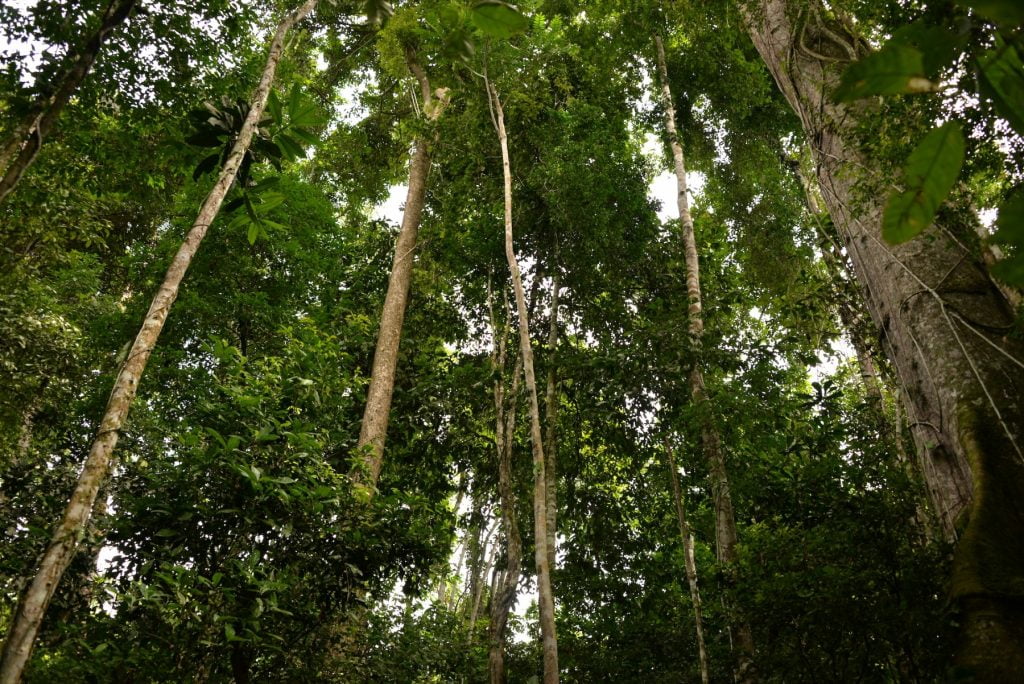Trees are truly amazing. Besides producing nearly half the earth’s oxygen, providing habitat for millions of species, and creating the soil and timber resources we depend on, trees also do one more surprising thing: they share resources, Israeli researchers show.
Weizmann Institute’s Dr. Tamir Klein recently made such a startling discovery that his supervisors at first declared that the finding must have been a mistake. In the forest, trees are known to compete for resources such as light and nutrients, but Klein found that the same trees also engage in sharing.
Klein showed that the carbon molecules taken up by the canopies of mature spruce trees were passed through the soil in surprisingly large quantities to neighboring beech, larch and pine. As Klein recently reported in the prestigious scientific journal Science, the carbon was being transferred via “underground highways” formed by overlapping networks of root fungi.
“Neighboring trees interact with one another in complex ways,” Klein said in a statement. “Of course, there is a great deal of competition among them, but they also form communities, sort of ‘guilds,’ within which individual trees share valuable resources. In fact, trees belonging to a ‘guild’ usually do much better than those that don’t.”
In his new lab at the Weizmann Institute, Klein follows these findings to investigate tree ecophysiology: how the tree functions in its ecosystem. “Studies on ‘underground’ tree collaboration may reveal which tree species get along well, and this may help determine which trees should be planted next to one another,” he says. “Our studies have additional relevance to forestry and agriculture because we elaborate on the mechanisms of growth and drought resistance of different tree species.”
Ideal climate for tree research
Only 5 percent of Israel’s land is covered by forest, but the country nonetheless offers unique advantages for forest research: Its warm climate provides an excellent opportunity for investigating how trees adapt to drought and stress. Many trees common to Israel are already resistant to drought; understanding the mechanisms that allow them to live with little rain may help develop varieties of lemons, almonds, olives and other tree crops that can grow in even drier areas.
SEE ALSO: Energy Does Grow On Trees, As Israelis Design First Solar Energy eTree
Klein’s projects aim to clarify how trees manage their water and carbon “budgets” – both separately and as a forest community. In one study the team focuses on emboli – tiny air bubbles that form inside the tree’s water channels during drought. When drought persists, the emboli can kill a tree, much like blood vessel clots that can cause a fatal heart attack in a human being. After injecting fluids into tree branches at different pressures, Klein and his students analyze the emboli in the minutest detail, using micro-computed tomography.
Sign up for our free weekly newsletter
SubscribeHugging trees – with measuring tape
In Weizmann’s greenhouses, Klein’s team members experiment with seedlings of pine, cypress, carob and other trees commonly found in Israel. The researchers make use of advanced technologies, including innovative nuclear magnetic resonance imaging, to study hydraulic conductivity in trees; a special lamp-equipped, below-ground camera is used to study the growth of tree roots in the soil.
When conducting field studies on their research plot near Beit Shemesh, Klein and his students hug trees – not to have a spiritual experience, but to follow a tree’s growth by encircling its trunk with a measuring tape. They apply laser isotope analysis and analytical chemistry techniques to trace carbon metabolism in individual trees, and they investigate carbon transfer among trees via different types of fungal “highways.” The scientists also employ thermal imaging, which enables remote temperature measurements, to study the rate of evaporation in the foliage.
In another set of experiments, Klein will double the concentration of CO2 to mimic the atmospheric conditions that may emerge on Earth as a result of pollution. Klein hasn’t owned a car in 10 years, so as not to contribute to CO2 emissions, but he warns against jumping to conclusions when it comes to the impact of increased CO2 on tree biology.
“Higher CO2 concentrations don’t help trees grow faster – contrary to the hopes of industrialists – but surprisingly, recent research suggests they might render the trees more resistant to drought-induced stress. This doesn’t mean it’s OK to carry on with CO2 pollution, but it does mean that we need to deepen our understanding of its effects on trees in general and on agricultural tree crops in particular.”
Overall, Klein’s studies could help predict how future climate changes, including global warming and the rise in greenhouse gases, may affect forests.
Photos and videos: Weizmann Institute, Stijn te Strake
Related posts

Resilient And Nutritious New Plant-Based Milk Aims To Make A Splash

Chocolate From Cultivated Cocoa Comes Without Environmental Toll

Plastic Fantastic: Startup Takes PVC Back To Its Crude Oil Roots






Facebook comments